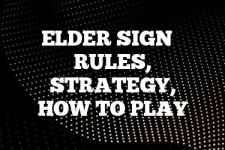Farkle: The Classic Dice Game – Rules, How to Play Instructions & Strategy
Introduction
Farkle is a pretty simple dice game that has been around for quite some time. It’s a game of risk and a little bit of strategy, where players roll dice to earn points, with the goal of reaching a score usually set at 10,000. I find the game to be a good one for players of all ages.

Farkle, also known as 10000, has a fair few variations and is known by different names in different places, but the basic premise remains the same. It’s often played at family gatherings and with friends in a group setting.
If you’re into the simplicity of Farkle but want to vary up your game nights, I recommend checking out Can’t Stop! which I’ve also written a guide on.
Quick Tip for Farkle
Always keep an eye on your opponents’ scores and risk levels—it can help you decide when to play it safe and when to go for big points!
Rules for playing Farkle
Understanding the rules of Farkle is key to enjoying the game. The game starts with players taking turns rolling six dice. After each roll, you must set aside at least one scoring die. The common scoring dice are ones, fives, three of a kind, three pairs, a straight of 1-6, and six of a kind.
Ones are worth 100 points, and fives are worth 50 points. Three of a kind is worth 100 times the number on the dice, except for three ones, which are worth 1,000 points. If you roll a straight or three pairs, you get 1,500 points. Six of a kind scores 3,000 points.
If you can’t set aside any scoring dice on a roll, that’s a Farkle, and you lose all points for that turn. If you decide to stop rolling and score your points, you pass the dice to the next player. But if you’re feeling lucky, you can keep rolling with the remaining dice to score more points. However, if you Farkle, you lose everything you’ve earned that turn. The first player to reach the set score wins the game.
Equipment and Setup for Farkle
To play Farkle, you need six dice, a flat surface, and a way to keep score, like a piece of paper and a pen. Players sit around the playing area, and someone is chosen to go first. The game proceeds in a clockwise direction from the first player.
How to Play Farkle
- Key Game Mechanics: Rolling dice, setting aside scoring dice, deciding to continue or stop rolling.
- Setup: Each player rolls one die to determine who goes first; the highest roll starts the game.
- Gameplay: On your turn, roll all six dice and set aside scoring dice. You can then choose to roll the remaining dice or stop and score your points.
- End of the Game: The game ends when a player reaches the set score, usually 10,000 points.
How to Win at Farkle
Winning at Farkle requires a mix of good luck and smart strategy. Beginners should focus on understanding scoring combinations and when to stop rolling. Intermediate players can start taking calculated risks based on their current score and their opponents’ scores. Advanced players will often go for high-scoring combinations and use psychological tactics to influence their opponents’ decisions.
Best Strategies for playing Farkle game
To win at Farkle, you need to balance risk and reward. One strategy is to stop rolling once you have a decent amount of points on the table, especially if you have fewer than three dice left.
The key strategy, overall, is to know when to stop rolling and “bank” your points, as the risk of farkling (rolling no points) increases with each additional throw. Players should often aim to keep high-scoring combinations like three of a kind or straight rolls, while also being mindful of single 1s and 5s, which can be worth banking if larger combinations seem unlikely.
Additionally, players should adapt their strategy based on their current standing in the game; for example, if you’re far behind, you might take more risks to catch up, while if you’re in the lead, it may be wiser to play conservatively. Keeping an eye on opponents’ scores and playing styles can also inform your decisions, as you’ll want to balance the pursuit of points with the need to prevent others from pulling ahead.
Lastly, understanding the probabilities of different dice combinations can help in making informed decisions about when to keep rolling and when to pass the dice.
Variations
There are many variations of Farkle that add twists to the game. I find it interesting (once you’ve got the hang of the game) to try different scoring rules, like requiring a minimum score before you can start banking points. Others introduce new dice with symbols that have special abilities, adding another layer of strategy to the game.
Scenarios
Good scenarios in Farkle include rolling a high-scoring combination early in your turn, giving you a strong start. Bad scenarios involve rolling a Farkle when you have a lot of points at stake. To turn these scenarios to your advantage, know when to be aggressive and when to play it safe based on your position in the game.
Frequently Asked Questions about playing Farkle game
- Q: What happens if I roll a Farkle? A: You lose all points for that turn and pass the dice to the next player.
- Q: Can I keep rolling even if I have scored with all six dice? A: Yes, you can start a new roll with all six dice, but if you Farkle, you lose all points from that turn.
- Q: Is there a penalty for multiple Farkles in a row? A: In some variations, multiple Farkles can lead to a point penalty, but in the standard game, there is no additional penalty.
Additional Tips and Tricks
Here are some extra tips for Farkle players:
- Always keep track of your opponents’ scores and strategies.
- Don’t get too greedy; know when to stop and bank your points.
- Practice makes perfect; the more you play, the better you’ll understand the odds and when to take risks.
External Links
Farkle Frenzy, a variation [Video]

Eve Brownlee was a gamer before gaming communities on the internet were a thing. Eve grew up playing traditional, standard deck card games like Rummy and Bezique, taking an interest in the classics Backgammon and Chess. Parlor card games like Bridge continue to keep Eve active in the community. After a long career, primarily in horticulture for USDA in Maryland, Eve now travels and writes on The Pineapple (pineapples.info) and contributes to Quora/Pinterest topics. Contact Eve via email.



